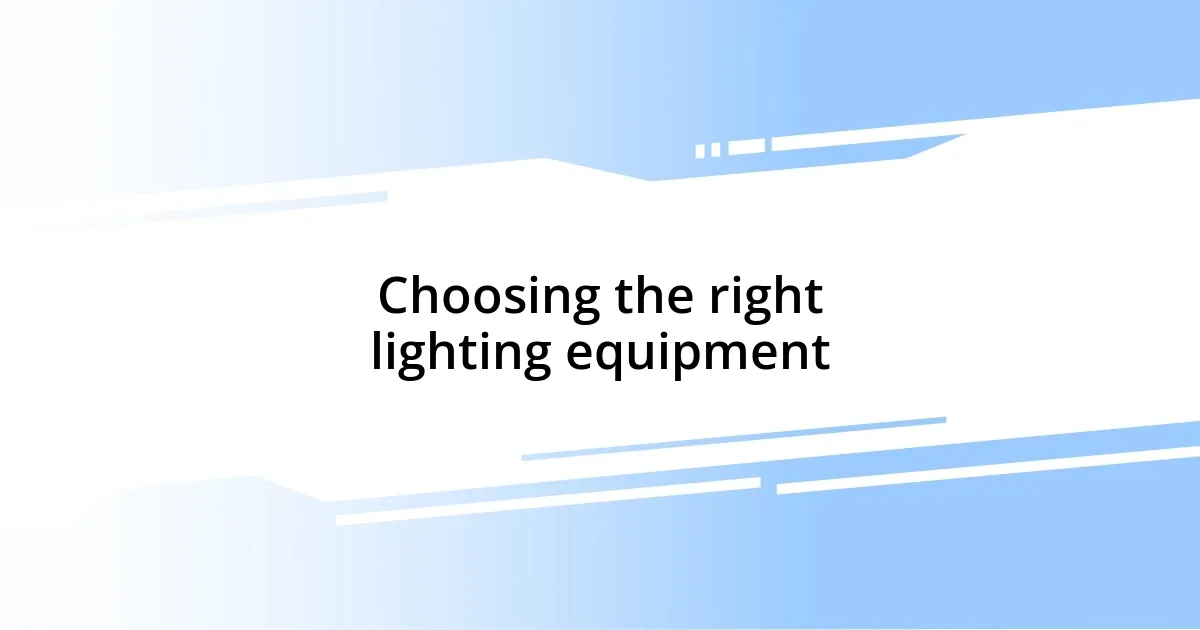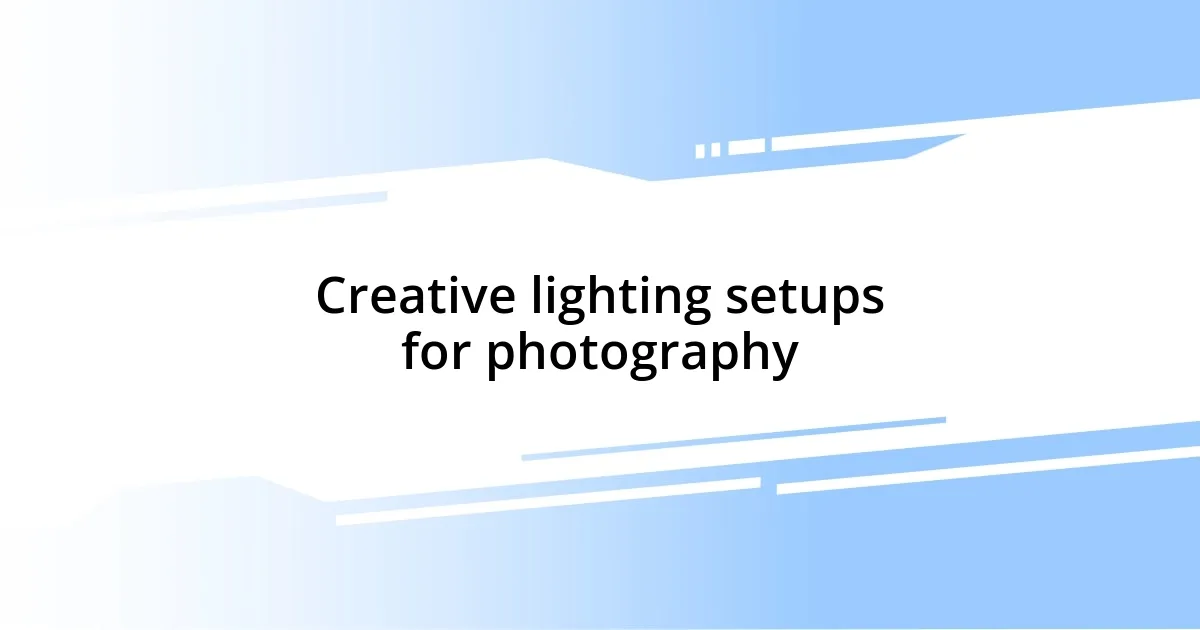Key takeaways:
- Lighting significantly influences the mood and perception of photography, with hard light evoking drama and soft light creating a flattering glow.
- Choosing the right lighting equipment and understanding how to manipulate light sources are essential for achieving desired effects in photography.
- Mastering natural light techniques includes utilizing backlighting, natural reflectors, and experimenting with timing for unique compositions.
- Post-processing adjustments, such as selective tweaks and color balance, can enhance the emotional impact of images and transform flat shots into dynamic visuals.

Understanding lighting fundamentals
Lighting is the backbone of any visual storytelling. I still remember the first time I experimented with natural light during a golden hour shoot. The way the soft, warm rays bathed my subject created an atmosphere that instantly elevated the entire image. It made me realize how a simple shift in light can dramatically change the mood and perception of a photograph.
Understanding the difference between hard and soft light is crucial. Hard light, with its sharp shadows and high contrast, can evoke a sense of drama or tension. In contrast, soft light wraps around your subject, providing a gentle, flattering glow. I often find myself asking, “What feeling do I want to convey?” This question guides my choice between these two lighting situations, helping me create images that resonate emotionally with viewers.
Then there’s the importance of color temperature, which can dramatically influence the scene’s mood. I recall a chilly morning shoot where I intentionally used warmer light to create a cozy atmosphere that felt inviting, even in the cold. The subtle hues transformed how the viewer experienced the image. This interplay of light and emotion is something I encourage every photographer to explore, as it opens up a whole new world of creative possibilities.

Choosing the right lighting equipment
Choosing the right lighting equipment can be a game-changer in achieving the desired effect in your work. I fondly recall my first purchase of a softbox; it was a modest investment but transformed my indoor shoots entirely. The soft, diffused light created the kind of dreamy portraits I used to envy in magazines. Each piece of equipment carries a unique quality that can enhance or alter your narrative.
Here’s a quick checklist to consider when selecting lighting equipment:
– Purpose: Determine whether you need natural, continuous, or flash lighting.
– Portability: Consider how easy it is to transport—will you be shooting in various locations?
– Power Source: Factor in whether you prefer battery-operated options or those requiring an outlet.
– Light Quality: Assess if you want soft light (with modifiers or diffusers) or hard light (like bare bulbs or strobe).
– Budget: Decide how much you’re willing to invest—there’s gear for every price range, and you don’t have to break the bank to start.
I remember the thrill of discovering reflectors in a local camera shop. They seemed simple, yet their ability to bounce light back onto my subjects opened up a new realm of creative control. Every time I use one, I think about how small adjustments can lead to big shifts in mood, which keeps me coming back for more experimentation.

Mastering natural light techniques
Mastering natural light techniques has truly transformed the way I approach photography. One of my favorite tips is to leverage the positioning of your subject in relation to the light source. I’ll often experiment with backlighting to create silhouettes, which can evoke a sense of mystery. I vividly remember a shoot where I positioned my subject against a stunning sunset. The result was mesmerizing—an ethereal quality that made the image feel almost surreal. That magical moment reaffirmed my belief that harnessing natural light can result in breathtaking images.
Another technique I find invaluable is using natural reflectors. I often scout locations for surfaces like water, sand, or even walls that can bounce light. There was a time I shot portraits by a lake, and the way the water reflected light back onto my subjects was remarkable. The soft illumination added depth and dimension, enhancing the overall ambiance. This simple approach can elevate your photography dramatically and gives you the chance to create unique compositions.
Finally, mastering the art of timing is essential when working with natural light. I have learned to embrace the beauty of different times of day—each one offering unique lighting conditions. During a recent afternoon session, I noticed how the harsh midday sun made colors pop and textures stand out. This skilful observation can lead to extraordinary results, allowing photographers to cultivate their own distinctive style while working with natural elements.
| Technique | Description |
|---|---|
| Backlighting | Position your subject against a light source for dramatic silhouettes. |
| Natural Reflectors | Use reflective surfaces to bounce light onto your subject, enhancing illumination. |
| Timing | Capture images during different times of day to utilize unique lighting conditions. |

Using artificial light for effects
Artificial light can truly elevate the mood and texture of your images. During one of my late-night shoots, I decided to use a colored gel over my flash for a creative portrait. The result was stunning—this unexpected pop of color brought a freshness to the image that caught everyone’s attention. Have you ever thought about the impact of color in your lighting choices? It can transform a simple scene into something you’ve never imagined.
When it comes to creating atmosphere, I often rely on my LED panels for versatility. They’re perfect for adding drama or softening a space. I remember a specific event where I wanted an intimate, cozy vibe. I placed the panels at varying intensities around the room, and the ambiance just shifted effortlessly. It’s fascinating how the right setup of artificial light can influence not just the image but also the emotional response of the viewer.
Lastly, I’ve learned the hard way that modifying your light source can make a significant difference. I once forgot to bring my diffuser to a shoot, and the harsh shadows it produced nearly derailed my vision. After that mishap, I made it a point to always have at least one modifier on hand. Have you had a similar experience where a simple accessory turned a challenge into a triumph? The right equipment can help you stay prepared for those unexpected moments in your creative journey.

Balancing light and shadow
Balancing light and shadow is an art that can deeply influence the mood of your photograph. There was a time I was shooting in a dense forest, where dappled light danced sporadically through the leaves. I realized that if I angled my camera to catch those slivers of sunlight, I could create a beautiful interplay of light and shadow that added layers of depth to the image. The contrast made the scene feel alive, almost as if the light itself was whispering secrets through the foliage.
I’ve often found that the right balance can evoke strong emotions. For instance, I was once photographing a couple during the golden hour, when warm light enveloped them while soft shadows caressed their faces. It struck me how this combination conveyed warmth and intimacy, pulling me deeper into their story. Have you ever captured a moment where the interplay of light and shadow told a narrative that words simply couldn’t express? That’s the magic of understanding light—by skillfully managing it, you create more than just pictures; you craft experiences.
Moreover, recognizing the importance of shadows is key. At a recent street photography session, I noticed how shadows can elongate and reshape reality. I pointed my camera toward a grand building at dusk, where shadows stretched dramatically across the pavement. This approach added a dramatic flair to my images that made even the mundane seem extraordinary. It made me question: when was the last time you let shadows play a crucial role in your photography? By reimagining how you see shadows, you can create striking compositions that resonate.

Creative lighting setups for photography
Creative lighting setups can transform your photography in remarkable ways. One evening, I decided to experiment with backlighting while capturing some portraits during sunset. By positioning my subjects in front of the setting sun, I was able to create a halo effect around them. This not only gave the photos a dreamy quality but also highlighted the joyous expressions on their faces. Have you ever tried backlighting? It can genuinely enhance the narrative and mood of your images.
In another scenario, I ventured into a dimly lit cafe, determined to bring out its cozy ambiance. I mounted a small LED light to my camera and directed it towards a table adorned with vintage books and warm beverages. The subtle illumination created soft highlights and drew attention to the intricate details around, such as the steam rising from a cup of coffee. It’s interesting how that little addition completely shifted the viewer’s focus; it turned an ordinary scene into an inviting story. What could you illuminate differently in your next shot to evoke a unique feeling?
One of my recent favorites is using practical lights as part of the scene. While shooting a musician at a local gig, I noticed the colorful stage lights dancing around him. Instead of flooding the scene with my own light, I embraced those hues. Capturing the artist bathed in blues and purples while his instrument gleamed under them created a vibe that resonated with the audience. Have you ever allowed ambient light to guide your photography? Embracing what’s already there can unlock new creative pathways you never thought possible.

Tips for post-processing lighting adjustments
When it comes to post-processing lighting adjustments, I’ve discovered that subtle tweaks can make a world of difference. Recently, I processed a landscape shot from a morning hike. I lowered the exposure just a touch to retain the soft glow of sunrise while slightly increasing the contrast to bring out the rich colors of the foliage. It was fascinating to see how these minor adjustments turned a flat image into something vibrant and dynamic. Have you ever been amazed at how a small change completely alters the viewing experience?
One of my go-to techniques in editing is using selective adjustments. This allows me to accentuate the areas where I want the light to pop while keeping other parts subdued. For example, while editing a portrait where the subject was illuminated by a window, I enhanced the brightness of their face and the soft glow of the background. This not only drew attention to their expression but also created a natural, inviting atmosphere. It’s incredible how a bit of focus can enhance the emotions captured in a single frame. Do you find yourself experimenting with selective adjustments? It might just lead you to surprising results.
Finally, I’ve learned the importance of color balance during post-processing, especially with artificial lights. I once edited a shoot from a vibrant carnival, where the reds and blues clashed in amusing ways. By adjusting the white balance, I harmonized those bold hues without losing their liveliness. The result was a lively image that conveyed the fun and energy of the moment. Have you tried adjusting color balance to elevate your images? It might help your photographs reflect the atmosphere you’ve so carefully captured.












